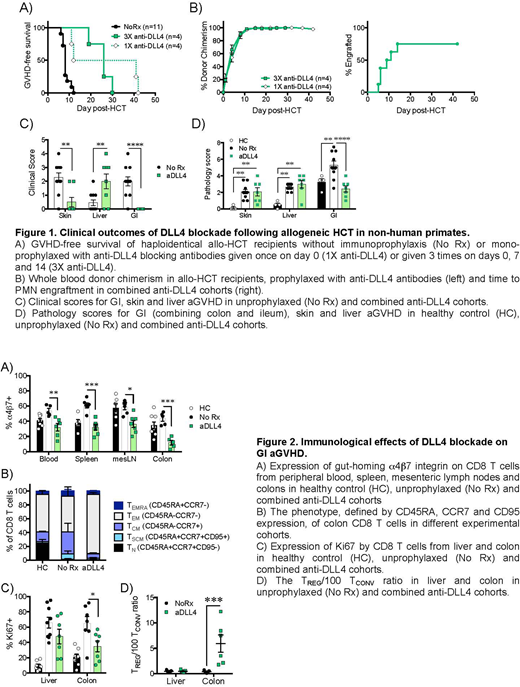Abstract
The Notch signaling pathway is an evolutionarily conserved, cell-cell communication system with critical functions in organogenesis and tissue homeostasis, including hemato- and immuno-poiesis. Recent data have revealed important roles for Notch in the regulation of mature T cell differentiation and function. Studies in mouse models have identified Notch as a critical regulator of pathogenic T-cell responses during acute GVHD (aGVHD) (Zhang Y, 2011, Blood). However, the exact biological effects and the therapeutic potential of Notch pathway manipulation in clinical settings remains unclear.
To address this question, we tested the activity of Notch pathway blockade in a non-human primate (NHP) aGVHD model, previously shown to exhibit donor T cell-intrinsic activation of the Notch pathway during aGVHD (Furlan SN, 2015, Sci Transl Med). To inhibit the Notch pathway, we used a blocking mAb to the Notch ligand DLL4, identified as the dominant ligand in a mouse aGVHD model (Tran, 2013, JCI; Chung, 2017, JCI).
Prophylactic treatment regimens with either a single administration of anti-DLL4 mAb on day 0 (3 mg/kg), or with 3 doses (3 mg/kg each) on days 0, 7 and 14 significantly improved GVHD-free survival of allo-HCT recipients (median survival time (MST) = 26.5 days for the single dose regimen, and MST = 26 days for the triple dose regimen) in comparison with unprophylaxed controls (MST = 8 days, p<0.005; Fig 1A). Importantly, donor cell engraftment and hematopoietic reconstitution were normal (Fig 1B). Of note, DLL4 blockade dramatically changed the clinical phenotype of break-through GVHD, providing complete protection from gastrointestinal (GI) aGVHD, and instead showing clinical manifestations predominantly restricted to liver (Fig 1C, D).
We next sought to determine the mechanism of GI aGVHD protection caused by DLL4 inhibition. Notably, anti-DLL4 GVHD prophylaxis decreased the expression of the gut-homing α4β7 integrin on CD8 T cells from the peripheral blood, spleen, mesenteric lymph nodes and colon in treated recipients (Fig 2A). Intestinal CD8 T cells also displayed a skewing towards a mature, effector-memory phenotype (Fig 2B) and reduced Ki67+ proliferation (Fig 2C). In contrast, CD8 T cells isolated from liver, the main site of break-through GVHD in anti-DLL4 mAb-treated animals, demonstrated a similar proliferation rate in anti-DLL4-treated compared to unprophylaxed cohorts (Fig 2C). Moreover, anti-DLL4 mAb prophylaxis was associated with an improved regulatory T cell/conventional T cell ratio in the colon but not in liver (Fig 2D).
Collectively, our results show that the function of individual Notch ligands is preserved from mice to primates in aGVHD. We provide the first demonstration of the important role of Notch signaling in alloimmune T cell activation in a large animal model of aGVHD, and the therapeutic potential of DLL4 blockade for aGVHD prevention.
Tkachev:Regeneron Pharmaceuticals, Inc.: Research Funding. Kuhnert:Regeneron Pharmaceuticals, Inc.: Employment. Blazar:Kadmon Corporation, LLC: Consultancy, Research Funding. Carpenter:Regeneron Pharmaceuticals, Inc.: Employment. Harari:Regeneron Pharmaceuticals, Inc.: Employment. Thurston:Regeneron Pharmaceuticals, Inc.: Employment, Equity Ownership. Kean:Regeneron Pharmaceuticals, Inc.: Research Funding.
Author notes
Asterisk with author names denotes non-ASH members.


This feature is available to Subscribers Only
Sign In or Create an Account Close Modal